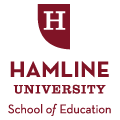Term
Fall 12-2-2015
Capstone
Thesis
Degree Name
MAESL
Primary Advisor/Dissertation Chair
Ann Mabbott
Secondary Advisor/Reader One
Emily Burt
Peer-Reviewer/Reader Two
Laurie Sutton
Abstract
The number of elementary STEM schools has risen dramatically in the last decade. The national government has identified goals for preparing learners for the workforce in the STEM areas, while also decreasing the achievement gap between white students and their non-white peers. This research paper seeks to answer three central questions: 1) How can these various STEM disciplines be integrated in an effective and meaningful manner to improve both academic language and content area knowledge of English Learners? 2) What lesson design format best prepares teachers to implement a project-based or integrated curriculum? 3) How can partnerships between higher education and K-12 public schools enrich students’ learning and promote authentic scientific inquiry? A unit on local water quality is provided as an example of curriculum integration to benefit English learners. The unit uses a modified backward design template that more clearly draws connections between content and language objectives.
Research Methodology
Curriculum Development, Document Studies, Program Evaluation
Keywords
ESL/ ELLs, Interdisciplinary Teaching, Science, STEM
Recommended Citation
Engelbret, Christian Joseph, "The Confluence of STEM Education and Language Learning: Curriculum Integration to Benefit Language Learners" (2015). School of Education and Leadership Student Capstone Theses and Dissertations. 250.
https://digitalcommons.hamline.edu/hse_all/250

